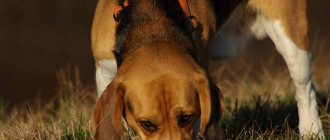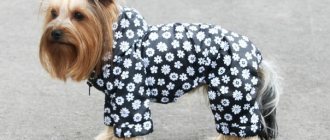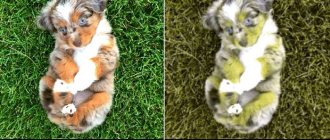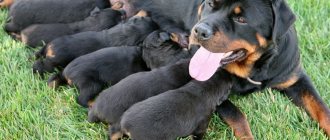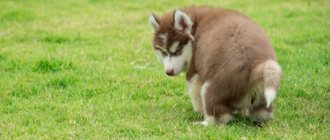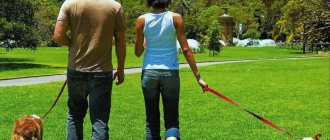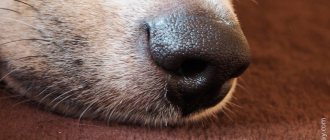A hernia in dogs requires mandatory treatment. This term is used to refer to a pathology accompanied by the prolapse of internal organs through natural or artificial openings into adjacent cavities, intermuscular space, or directly under the skin. If you contact the veterinarian too late, these formations can lead to the death of your pet.
Why does pathology appear?
The causes of pathology depend on age. A hernia in puppies occurs shortly after birth at the site of the umbilical ring. This is due to weak abdominal muscles, poor tissue regeneration and the non-standard shape of the navel, which prevents it from contracting on its own after cutting the umbilical cord.
Dehiscence of the umbilical commissure in adult animals is observed in the presence of a number of unfavorable factors. These include:
- Increased intra-abdominal pressure. The difference occurs during pregnancy and too intense physical activity. The risk group includes hunting and sledding breeds.
- Loss of muscle tone. With age, muscles weaken, so this disorder is often diagnosed in older dogs. A similar situation occurs in low-active animals.
- Complications resulting from abdominal injuries, operations and diseases of the cardiovascular system.
- Flatulence, constipation, kidney pathologies, frequent vomiting or severe cough.
Separately, a genetic predisposition is distinguished in bull terriers, German shepherds, poodles, dachshunds and spaniels. Puppies born from sick parents often inherit similar anomalies - pathological holes inside the peritoneum that contribute to organ prolapse.
Causes of hernia
A hernia is a protrusion of internal organs through natural or pathological openings due to rupture of abdominal tissue (hernial orifice). The most common contents of the hernial sac are intestinal loops, uterus, bladder, mesentery (omentum). Veterinary practice shows that the disease can be congenital, as well as acquired.
Congenital hernia
Most often, veterinarians are faced with umbilical congenital hernia. Hereditary predisposition in this case plays a major role in the pathophysiology of the process. The cause of the development of the birth defect is a wide inguinal canal, as well as an unclosed umbilical opening.
Many dog breeders believe that improper care of newborn puppies during birth can lead to pathology.
Acquired
The causes of acquired disease in veterinary medicine include:
- Injuries . Blows, being hit by a vehicle, falling from a height, mechanical damage to the abdominal organs during fights with relatives are the most common causes of the development of acquired inguinal and umbilical hernia.
- Increased intra-abdominal pressure. Chronic heart and vascular diseases, kidney pathologies, difficult pathological childbirth, chronic constipation often lead to increased pressure in the peritoneum and contribute to the protrusion of internal organs.
Factors contributing to the development of the defect include obesity, weakened muscle tone, and excessive physical activity.
Hernia after surgery
Hernia as a complication after abdominal surgery is a rare occurrence. In dogs, pathology can develop as a result of urethrostomy, sterilization of females, intestinal operations and other surgical interventions.
How dangerous is a hernia in a dog?
A hernia in a pregnant dog's stomach can lead to the death of the puppies. The likelihood of death increases in the second half of pregnancy, when the uterus increases significantly in size.
Due to the resulting infringement, the mother herself may die, so it is very important not to miss the moment and carry out a timely operation. But even with a successful outcome, the sick pet must be excluded from further breeding.
Other complications include:
- kidney failure and problems with urination that occur when the bladder is pinched;
- prolonged bouts of vomiting and constipation, characteristic of intestinal damage;
- general intoxication of the body;
- development of inflammation, including acute sepsis;
- local or extensive necrosis.
As a result of these violations, the animal may fall into a coma and die. For this reason, you should not delay diagnosis when the first warning signs are detected.
Symptoms depending on the type
Symptoms of a hernia in dogs depend on the type. When classifying, they are based on the appearance, degree of danger and the cause of the formation.
True or false
The hernial sac always resembles a spherical protrusion. In the true variety, its diameter is more than 2 cm and is constantly increasing, reaching the size of a chicken egg or an orange. This cannot be done without treatment, since the organs trapped inside the formation gradually become compressed and die.
The prognosis for the false variety is favorable. A soft small (up to 2 cm) ball is formed on the body, which is very easily smoothed out. Fat accumulates inside it, so surgery to realign the organs is not required.
Reducible or solid
The pathology is called reducible when all the prolapsed organs easily return to their place. If the situation is completely opposite, then the formation is called irreducible, or hard. It occurs due to inflammation, when the pinched organ increases in size and cannot return back through the hernial orifice.
Congenital or acquired
Congenital disorders include all cases associated with poor heredity or unsuccessful birth. If it occurs later, the pathology is called acquired.
Division by type depending on location
Photos of a hernia in dogs differ depending on its location. Some formations are clearly visible to the naked eye, while others can only be diagnosed using special equipment.
Inguinal
Inguinal hernia is common in small breed dogs that are prone to obesity. It occurs directly in the groin and is characterized by the following symptoms:
- increased temperature at rest;
- oppression;
- the appearance of shortness of breath;
- increased heart rate;
- nausea and vomiting;
- involuntary urination or complete absence of urge.
When palpating the oblong swelling, the pet experiences acute pain. In females it is concentrated in the area of the loop, and in males - in the area of the testes.
Intervertebral
Accompanied by the appearance of a hernial sac in the area of the vertebrae and leads to dysfunction of the intervertebral discs. The risk group includes older animals that have been engaged in vigorous physical activity for a long time (sled racing, agility, freestyle, professional hunting).
The bulging vertebral cartilage affects the nerves in the spinal canal, causing severe back pain, lameness and paralysis. The pet loses its usual activity, increasingly giving up outdoor games and too long walks.
Umbilical
It occurs most often at the navel. The intestines, omentum and other nearby organs fall out into the ruptured ring. Usually puppies suffer from this pathology, but pets with frequent constipation and increased gas production are also at risk.
Diaphragmatic or hiatal
Diaphragmatic hernia in dogs can be congenital or acquired. In the second case, it occurs with injuries to the chest and abdomen, when the contents of the abdominal cavity rise beyond the diaphragm. It causes breathing problems, blue mucous membranes, anemia and nausea. In an advanced form, the sick animal develops pulmonary edema and heart failure.
Perineal
It differs from the inguinal one in that it forms near the anus on one or both sides. The risk group includes uncastrated males.
The perineal lump is soft, but very painful to the touch. It gradually grows, disrupting bowel movements and urination. Most often, its contents are represented by the prostate gland, bladder, part of the intestines or uterus.
Diagnostics
Approximately half of traumatic diaphragmatic hernias are accompanied by severe respiratory symptoms: rapid breathing, asthma attacks, respiratory rhythm disturbances, blue discoloration of the mucous membranes, tips of the ears and tongue. And also a characteristic symptom of damage to the diaphragm is the hollowing of the abdominal wall during inspiration and relief of the condition in a suspended state.
A significant deterioration in condition is observed when the animal descends the stairs. To confirm the diagnosis, it is necessary to undergo an X-ray examination of the chest and abdominal cavity, in some cases an X-ray with contrast is recommended, an electrocardiogram and echocardiography of the heart, and an ultrasound examination of the abdominal organs.
The main method for detecting diaphragmatic rupture is x-ray examination. It is on the X-ray that the prolapse of organs from the peritoneum into the chest is clearly visible.
An x-ray can determine:
- intermittency of the diaphragm contour;
- the contents of the peritoneum inside the chest;
- displacement of thoracic structures;
- displacement of abdominal organs;
- divergence of the legs of the diaphragm.
Diagnosis and surgery
A plan for eliminating a hernia in dogs is drawn up only after a comprehensive diagnosis. In addition to a general examination and palpation, the veterinarian may prescribe an ultrasound, x-ray and endoscopy. These studies help determine the type and cause of the formation, the nature of its contents and the presence of organ displacement.
In mild cases, conservative therapy is used. It is suitable for the treatment of small reducible and false pathologies. The dropped entrails are put back into place manually. The discrepancy at the navel is fixed with a coin or a hard plate. As a preventative measure, several massage sessions are prescribed.
In all other cases, treatment is strictly surgical. The intervention is performed under general anesthesia. During the operation, the surgeon opens the hernial sac, sets the prolapsed organs, puts sutures on the wound and treats it with an antiseptic. In the presence of necrosis or abscess, additional excision of dead tissue and cleaning of accumulated pus is performed.
Prevention of hernia formation
In order to prevent the disease, veterinary specialists and experienced breeders recommend that owners adhere to the following rules and advice:
- Buy puppies only from responsible breeders.
- When choosing a baby, pay attention to his health, check for any protrusion in the navel area.
- Avoid chronic constipation in your pets.
- Treat concomitant diseases in a timely manner.
- Castration of male dogs reduces the risk of developing a perineal hernia.
- Prevent injuries and mechanical damage to internal organs in dogs.
Umbilical hernia in dogs is most often diagnosed in puppies and young animals. Inguinal, perineal and diaphragmatic hernia are observed with injuries and increased intra-abdominal pressure. These types of pathology are fraught with strangulation of the hernial contents.
A diaphragmatic hernia requires immediate surgical intervention. Vertebral tissue develops as a result of degenerative processes in the cartilage tissue of the spine. Conservative treatment is ineffective; surgery requires a highly qualified doctor.
Rehabilitation and care after surgery
After hernia surgery, the regeneration process in dogs takes 7-10 days. During this time, it is recommended to wear an Elizabethan collar and bandage to prevent damage to the seams.
To avoid complications, the owner needs to keep the wound dry and clean, and if the suture material comes apart, bleeding or pus appears, immediately consult a doctor.
In addition to antiseptic treatment, the following may be prescribed for patient care :
- analgesics that alleviate pain;
- antibiotics that protect against secondary infection;
- immunomodulators that increase the immune response.
During the first few days, your pet will recover from anesthesia. Due to dizziness, nausea and poor coordination, he may refuse to eat and even walk under himself. This is absolutely normal, so do not force feed him, protect him from injury and provide him with a comfortable and safe place right on the floor.
Before the sutures are removed, you should avoid your usual activities. Stop running and jumping. It is better to carry small dogs in your arms, preventing them from going up and down the stairs on their own. When walking, be sure to use a leash to control your pet's movements.

